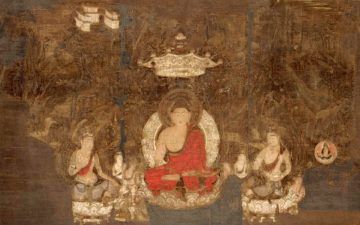Sam Dresser in aeon:
 At Wat Doi Kham, my local temple in Chiang Mai in Thailand, visitors come in their thousands every week. Bearing money and garlands of jasmine, the devotees prostrate themselves in front of a small Buddha statue, muttering solemn prayers and requesting their wishes be granted. Similar rituals are performed in Buddhist temples across Asia every day and, as at Wat Doi Kham, their focus is usually a mythic representation of the Buddha, sitting serenely in meditation, with a mysterious half-smile, withdrawn and aloof. It is not just Buddhist temples in which the Buddha exists in an entirely mythic form. Buddhist scholars, bewildered by layers of legend as thick as clouds of incense, have mostly given up trying to understand the historical person. This might seem strange, given the ongoing relevance of the Buddha’s ideas and practices, most lately seen in the growing popularity of mindfulness meditation. As Western versions of Buddhism emerge, might space be made for the actual Buddha, a lost sage from ancient India? Might it be possible to separate myth from reality, and so bring the Buddha back into the contemporary conversation?
At Wat Doi Kham, my local temple in Chiang Mai in Thailand, visitors come in their thousands every week. Bearing money and garlands of jasmine, the devotees prostrate themselves in front of a small Buddha statue, muttering solemn prayers and requesting their wishes be granted. Similar rituals are performed in Buddhist temples across Asia every day and, as at Wat Doi Kham, their focus is usually a mythic representation of the Buddha, sitting serenely in meditation, with a mysterious half-smile, withdrawn and aloof. It is not just Buddhist temples in which the Buddha exists in an entirely mythic form. Buddhist scholars, bewildered by layers of legend as thick as clouds of incense, have mostly given up trying to understand the historical person. This might seem strange, given the ongoing relevance of the Buddha’s ideas and practices, most lately seen in the growing popularity of mindfulness meditation. As Western versions of Buddhism emerge, might space be made for the actual Buddha, a lost sage from ancient India? Might it be possible to separate myth from reality, and so bring the Buddha back into the contemporary conversation?
The legendary version of the Buddha’s life states that the Siddhattha Gotama was born as a prince of the Sakya tribe, and raised in the town of Kapilavatthu, several centuries before the Christian era. Living in luxurious seclusion, Siddhattha remained unaware of the difficulties of life, until a visit beyond the palace walls revealed four shocking sights: a sick man, an old man, a dead man and a holy man. The existential crisis this sparked led Siddhattha to renounce the world, in order to seek a spiritual solution to life. After six years of trying out various practices, including extreme asceticism, at the age of 35 Siddhattha attained spiritual realisation. Henceforth known as the ‘Buddha’ – which simply means ‘awakened’ – Siddhattha spent the rest of his life travelling around northern India and establishing a new religious order. He died at the age of 80.
Only the bare details of this account stand up to historical scrutiny. According to contemporary academic opinion, the Buddha lived in the 5th century BCE (c480-400 BCE). But the failure to identify Kapilavatthu implies that he was not a prince who lived in a grand palace. The most likely sites are the Nepalese site of Tilaurakot, an old market town about 10 km north of the Indian border, and the Indian district of Piprahwa, to the south of Tilaurakot and just over the Indian border. But the brick remains at both places are a few centuries later than the Buddha, which at least agrees with the oldest literary sources: according to the Pali canon – the only complete collection of Buddhist literature from ancient India – the Buddha’s world generally lacked bricks, and Kapilavatthu’s only building of note was a tribal ‘meeting hall’ (santhāgāra), an open-sided, thatched hut (sālā).
More here.
